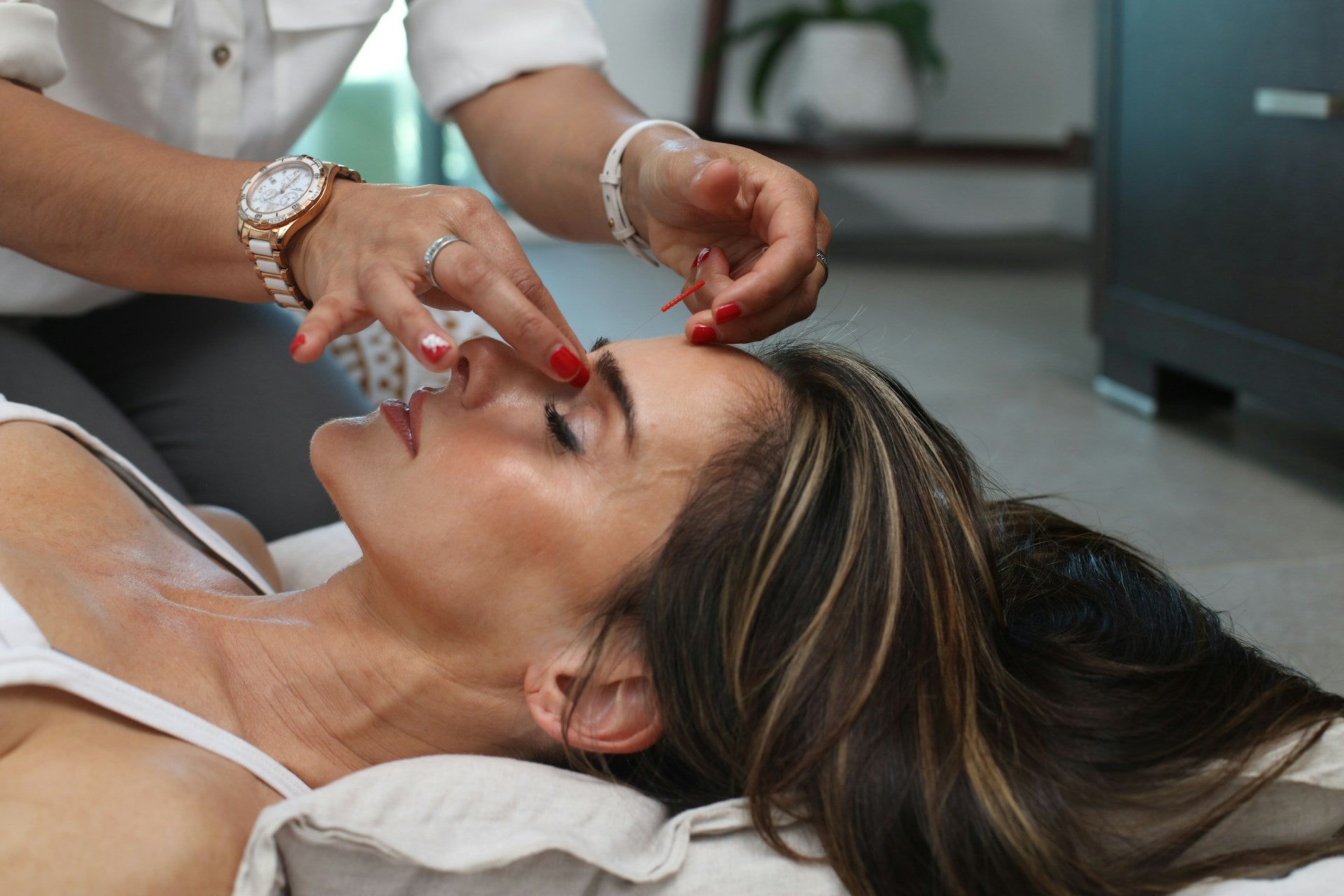INFORMATION FROM
U.S. DEPARTMENT OF HEALTH & HUMAN SERVICES – NATIONAL INSTITUTES OF HEALTH (NIH)
INTRODUCTION
Iodine is a trace element that is naturally present in some foods, added to others, and available as a dietary supplement. Iodine is an essential component of the thyroid hormones thyroxine (T4) and triiodothyronine (T3). Thyroid hormones regulate many important biochemical reactions, including protein synthesis and enzymatic activity, and are critical determinants of metabolic activity <1,2>. They are also required for proper skeletal and central nervous system development in fetuses and infants <1>. Thyroid function is primarily regulated by thyroid-stimulating hormone (TSH), also known as thyrotropin. It is secreted by the pituitary gland to control thyroid hormone production and secretion, thereby protecting the body from hypothyroidism and hyperthyroidism <1>. TSH secretion increases thyroidal uptake of iodine and stimulates the synthesis and release of T3 and T4. In the absence of sufficient iodine, TSH levels remain elevated, leading to goiter, an enlargement of the thyroid gland that reflects the body’s attempt to trap more iodine from the circulation and produce thyroid hormones. Iodine may have other physiological functions in the body as well. For example, it appears to play a role in immune response and might have a beneficial effect on mammary dysplasia and fibrocystic breast disease <2>. The earth’s soils contain varying amounts of iodine, which in turn affects the iodine content of crops. In some regions of the world, iodine-deficient soils are common, increasing the risk of iodine deficiency among people who consume foods primarily from those areas. Salt iodization programs, which many countries have implemented, have dramatically reduced the prevalence of iodine deficiency worldwide <2,3>. Iodine in food and iodized salt is present in several chemical forms including sodium and potassium salts, inorganic iodine (I2), iodate, and iodide, the reduced form of iodine <4>. Iodine rarely occurs as the element, but rather as a salt; for this reason, it is referred to as iodide and not iodine. Iodide is quickly and almost completely absorbed in the stomach and duodenum. Iodate is reduced in the gastrointestinal tract and absorbed as iodide <2,5>. When iodide enters the circulation, the thyroid gland concentrates it in appropriate amounts for thyroid hormone synthesis and most of the remaining amount is excreted in the urine <2>. The iodine-replete healthy adult has about 15–20 mg of iodine, 70%–80% of which is contained in the thyroid <6>. Median urinary iodine concentrations of 100–199 mcg/L in children and adults, 150–249 mcg/L in pregnant women and >100 mcg/L in lactating women indicate iodine intakes are adequate <3>. Values lower than 100 mcg/L in children and non-pregnant adults indicate insufficient iodine intake, although iodine deficiency is not classified as severe until urinary iodine levels are lower than 20 mcg/L. Recommended Intakes Intake recommendations for iodine and other nutrients are provided in the Dietary Reference Intakes (DRIs) developed by the Food and Nutrition Board (FNB) at the Institute of Medicine of the National Academies (formerly National Academy of Sciences) <2>. DRI is the general term for a set of reference values used for planning and assessing nutrient intakes of healthy people. These values, which vary by age and gender <2>, include:- Recommended Dietary Allowance (RDA): Average daily level of intake sufficient to meet the nutrient requirements of nearly all (97%–98%) healthy individuals; often used to plan nutritionally adequate diets for individuals.
- Adequate Intake (AI): Intake at this level is assumed to ensure nutritional adequacy; established when evidence is insufficient to develop an RDA.
- Estimated Average Requirement (EAR): Average daily level of intake estimated to meet the requirements of 50% of healthy individuals; usually used to assess the nutrient intakes of groups of people and to plan nutritionally adequate diets for them; can also be used to assess the nutrient intakes of individuals.
- Tolerable Upper Intake Level (UL): Maximum daily intake unlikely to cause adverse health effects.
- Includes a variety of vegetables, fruits, whole grains, fat-free or low-fat milk and milk products, and oils. Milk is an excellent source of iodine. Fruits, vegetables, and bread also provide small quantities of iodine.
- Includes a variety of protein foods, including seafood, lean meats and poultry, eggs, legumes (beans and peas), nuts, seeds, and soy products. Some fish contain high amounts of iodine. Eggs are also good sources of iodine.
- Limits saturated and trans fats, added sugars, and sodium.
- Stays within your daily calorie needs.
- National Research Council, Committee to Assess the Health Implications of Perchlorate Ingestion. Health Implications of Perchlorate Ingestion. Washington, DC: The National Academies Press, 2005.
- Institute of Medicine, Food and Nutrition Board. Dietary Reference Intakes for Vitamin A, Vitamin K, Arsenic, Boron, Chromium, Copper, Iodine, Iron, Manganese, Molybdenum, Nickel, Silicon, Vanadium, and Zinc. Washington, DC: National Academy Press, 2001.
- World Health Organization. United Nations Children’s Fund & International Council for the Control of Iodine Deficiency Disorders. Assessment of iodine deficiency disorders and monitoring their elimination. 3rd ed. Geneva, Switzerland: WHO, 2007.
- Patrick L. Iodine: deficiency and therapeutic considerations. Altern Med Rev. 2008 Jun;13(2):116-127.
- Zimmermann MB. Iodine deficiency. Endocr Rev. 2009 Jun;30(4):376-408.
- Zimmermann MB, Jooste PL, Pandav CS. Iodine-deficiency disorders. Lancet. 2008 Oct 4;372(9645):1251-1262.
- WHO Secretariat, Andersson M, de Benoist B, Delange F, Zupan J. Prevention and control of iodine deficiency in pregnant and lactating women and in children less than 2-years-old: conclusions and recommendations of the Technical Consultation. Public Health Nutr. 2007 Dec;10(12A):1606-1611.
- Pennington JA, Young B. Iron, zinc, copper, manganese, selenium, and iodine in foods from the United States Total Diet Study. J Food Compost Anal. 1990 June;3(2):166-184.
- Murray CW, Egan SK, Kim H, Beru N, Bolger PM. US Food and Drug Administration’s Total Diet Study: dietary intake of perchlorate and iodine. J Expo Sci Environ Epidemiol. 2008 Nov;18(6):571-580.
- Pennington JAT, Schoen SA, Salmon GD, Young B, Johnson RD, Marts RW. Composition of Core Foods of the U.S. Food Supply, 1982-1991. III. Copper, Manganese, Selenium, and Iodine. J Food Comp Anal. 1995;8(2):171-217.
- Teas J, Pino S, Critchley A, Braverman LE. Variability of iodine content in common commercially available edible seaweeds. Thyroid. 2004 Oct;14(10):836-841.
- Dasgupta PK, Liu Y, Dyke JV. Iodine nutrition: iodine content of iodized salt in the United States. Environ Sci Technol. 2008 Feb 15;42(4):1315-1323.
- U.S. Food and Drug Administration. Food Labeling: Revision of the Nutrition and Supplement Facts Labels. 2016.
- U.S. Department of Agriculture, Agricultural Research Service. FoodData Central, 2019.
- Global Fortification Data Exchange. Fortification Legislation.
- UNICEF Data. Iodized salt data.
- U.S. Food and Drug Administration, Code of Federal Regulations, CFR 21, Sections 184.1634 and 184.1265. Revised April 1, 2009.
- Aquaron R, Delange F, Marchal P, Lognoné V, Ninane L. Bioavailability of seaweed iodine in human beings. Cell Mol Biol (Noisy-le-grand). 2002 Jul;48(5):563-569.
- Abt E, Spungen J, Pouillot R, Gamalo-Siebers M, Wirtz M. Update on dietary intake of perchlorate and iodine from U.S. food and drug administration’s total diet study: 2008-2012. J Expo Sci Environ Epidemiol 2018;28:21-30.
- Pennington JA, Young BE, Wilson DB. Nutritional elements in U.S. diets: results from the Total Diet Study, 1982 to 1986. J Am Diet Assoc. 1989 May;89(5):659-664.
- Pennington JA, Young BE. Total diet study nutritional elements, 1982-1989. J Am Diet Assoc. 1991 Feb;91(2):179-183.
- Centers for Disease Control and Prevention (CDC). National Center for Health Statistics (NCHS). National Health and Nutrition Examination Survey Data. Hyattsville, MD: U.S. Department of Health and Human Services, Centers for Disease Control and Prevention. Accessed 11/14/2009.
- Ristic-Medic D, Piskackova Z, Hooper L, Ruprich J, Casgrain A, Ashton K, Pavlovic M, Glibetic M. Methods of assessment of iodine status in humans: a systematic review. Am J Clin Nutr. 2009 Jun;89(6):2052S-2069S.
- Zimmermann MB. Methods to assess iron and iodine status. Br J Nutr. 2008 Jun;99 Suppl 3:S2-9.
- König F, Andersson M, Hotz K, Aeberli I, Zimmermann MB. Ten repeat collections for urinary iodine from spot samples or 24-hour samples are needed to reliably estimate individual iodine status in women. J Nutr 2011;141:2049-54.
- Caldwell KL, Miller GA, Wang RY, Jain RB, Jones RL. Iodine status of the U.S. population, National Health and Nutrition Examination Survey 2003-2004. Thyroid. 2008 Nov;18(11):1207-1214.
- Hollowell JG, Staehling NW, Hannon WH, Flanders DW, Gunter EW, Maberly GF, Braverman LE, Pino S, Miller DT, Garbe PL, DeLozier DM, Jackson RJ. Iodine nutrition in the United States. Trends and public health implications: iodine excretion data from National Health and Nutrition Examination Surveys I and III (1971-1974 and 1988-1994). J Clin Endocrinol Metab. 1998 Oct;83(10):3401-3408.
- Pennington JA, Schoen SA. Total diet study: estimated dietary intakes of nutritional elements, 1982-1991. Int J Vitam Nutr Res. 1996;66(4):350-362.
- Poulsen E. Case study: erythrosine. Food Addit Contam. 1993 May-Jun;10(3):315-323.
- Caldwell KL, Makhmudov A, Ely E, Jones RL, Wang RY. Iodine Status of the U.S.Population, National Health and Nutrition Examination Survey, 2005-2006 and 2007-2008. Thyroid. 2011 Feb 16.
- Perrine CG, Herrick KA, Gupta PM, Caldwell KL. Iodine status of pregnant women and women of reproductive age in the United States. Thyroid 2019;29:153-4.
- Perrine CG, Herrick K, Serdula MK, Sullivan KM. Some subgroups of reproductive age women in the United States may be at risk for iodine deficiency. J Nutr. 2010 Aug;140(8):1489-1494.
- Charlton KE, Gemming L, Yeatman H, Ma G. Suboptimal iodine status of Australian pregnant women reflects poor knowledge and practices related to iodine nutrition. Nutrition. 2010 Oct;26(10):963-8.
- Tayie FA, Jourdan K. Hypertension, dietary salt restriction, and iodine deficiency among adults. Am J Hypertens. 2010 Oct;23(10):1095-1102.
- Iodine Global Network.
- Santiago-Fernandez P, Torres-Barahona R, Muela-Martínez JA, Rojo-Martínez G, García-Fuentes E, Garriga MJ, León AG, Soriguer F. Intelligence quotient and iodine intake: a cross-sectional study in children. J Clin Endocrinol Metab. 2004 Aug;89(8):3851-3857.
- Levie D, Korevaar TIM, Bath SC, Murcia M, Dineva M, Llop S, Espada M, van Herwaarden AE, de Rijke YB, Ibarluzea JM, Sunyer J, Tiemeier H, Rayman MP, Guxens M, Peeters RP. Association of maternal iodine status with child IQ: A meta-analysis of individual participant data. J Clin Endocrinol Metab 2019;104:5957-67.
- Vermiglio F, Lo Presti VP, Moleti M, Sidoti M, Tortorella G, Scaffidi G, Castagna MG, Mattina F, Violi MA, Crisà A, Artemisia A, Trimarchi F. Attention deficit and hyperactivity disorders in the offspring of mothers exposed to mild-moderate iodine deficiency: a possible novel iodine deficiency disorder in developed countries. J Clin Endocrinol Metab. 2004 Dec;89(12):6054-6060.
- Zimmermann MB, Galetti V. Iodine intake as a risk factor for thyroid cancer: A comprehensive review of animal and human studies. Thyroid Res 2015;8:8.
- Cooper LF, Barber EM, Mitchell HS. Nutrition in Health and Disease, 9th ed. J.B. Lippincott Co, Philadelphia. 1943, pg 66.
- The Iodine Global Network. Global scorecard of iodine nutrition in 2019.
- Hess SY. The impact of common micronutrient deficiencies on iodine and thyroid metabolism: the evidence from human studies. Best Pract Res Clin Endocrinol Metab. 2010 Feb;24(1):117-132.
- UNICEF. The State of the World’s Children 2019.
- Melse-Boonstra A, Jaiswal N. Iodine deficiency in pregnancy, infancy and childhood and its consequences for brain development. Best Pract Res Clin Endocrinol Metab. 2010 Feb;24(1):29-38.
- Zimmermann MB. Iodine deficiency in pregnancy and the effects of maternal iodine supplementation on the offspring: a review. Am J Clin Nutr. 2009 Feb;89(2):668S-672S.
- Delange F. Iodine requirements during pregnancy, lactation and the neonatal period and indicators of optimal iodine nutrition. Public Health Nutr. 2007 Dec;10(12A):1571-1580.
- Pearce EN, Bazrafshan HR, He X, Pino S, Braverman LE. Dietary iodine in pregnant women from the Boston, Massachusetts area. Thyroid. 2004 Apr;14(4):327-328.
- Hollowell JG, Haddow JE. The prevalence of iodine deficiency in women of reproductive age in the United States of America. Public Health Nutr. 2007 Dec;10(12A):1532-1539; discussion 1540-1541.
- Bath SC, Steer CD, Golding J, Emmett P, Rayman MP. Effect of inadequate iodine status in UK pregnant women on cognitive outcomes in their children: Results from the Avon Longitudinal Study of Parents and Children (ALSPAC). Lancet 2013;382:331-7.
- Hynes KL, Otahal P, Burgess JR, Oddy WH, Hay I. Reduced educational outcomes persist into adolescence following mild iodine deficiency in utero, despite adequacy in childhood: 15-year follow-up of the gestational iodine cohort investigating auditory processing speed and working memory. Nutrients 2017;9:1354.
- Abel MH, Brandlistuen RE, Caspersen IH, Aase H, Torheim LE, Meltzer HM, Brantsaeter AL. Language delay and poorer school performance in children of mothers with inadequate iodine intake in pregnancy: Results from follow-up at 8 years in the Norwegian Mother and Child Cohort Study. European Journal of Nutrition 2019;58:3047-58.
- Gowachirapant S, Jaiswal N, Melse-Boonstra A, Galetti V,Stinca S, Mackenzie I, et al. Effect of iodine supplementation in pregnant women on child neurodevelopment: A randoised, double-blind, placebo-controlled trial. Lancet Diabetes Endocrinol 2017;5:853-63.
- Zhou SJ, Skeaff SA, Ruan P, Doyle LW, Anderson PJ, Komman L, et al. The effect of iodine supplementation in pregnancy on early childhood neurodevelopment and clinical outcomes: Results of an aborted randomised placebo-controlled trial. Trials 2015;16:563.
- Dineva M, Fishpool H, Rayman MP, Mendis J, Bath SC. Systematic review and meta-analysis of the effects of iodine supplementation on thyroid function and child neurodevelopment in mildly-to-moderately iodine-deficient pregnant women. Am J Clin Nutr. 2020. Published online ahead of print.
- Pearce EN, Leung AM, Blount BC, Bazrafshan HR, He X, Pino S, Valentin-Blasini L, Braverman LE. Breast milk iodine and perchlorate concentrations in lactating Boston-area women. J Clin Endocrinol Metab. 2007 May;92(5):1673-1677.
- Andersson M, Aeberli I, Wüst N, Piacenza AM, Bucher T, Henschen I, Haldimann M, Zimmermann MB. The Swiss Iodized Salt Program Provides Adequate Iodine for School Children and Pregnant Women, but Weaning Infants Not Receiving Iodine-Containing Complementary Foods as well as Their Mothers Are Iodine Deficient. J Clin Endocrinol Metab 2010;95:5217-24.
- Fallah R, Du L, Braverman LE, He X, Segura-Harrison M, Yeh MW, et al. Iodine nutrition in weaning infants in the United States. Thyroid 2019;29:573-6.
- Alexander EK, Pearce EN, Brent GA, Brown RS, Chen H, Dosiou C, et al. 2017 guidelines of the American Thyroid Association for the diagnosis and management of thyroid disease during pregnancy and the postpartum. Thyroid 2017;27:315-89.
- Council on Environmental Health, Rogan WJ, Paulson JA, Baum C, Brock-Utne AC, Brumberg HL, et al. Iodine deficiency, pollutant chemicals, and the thyroid: New information on an old problem. Pediatrics 2014;133:1163-6.
- Patel A, Lee SY, Stagnaro-Green A, MacKay D, Wong AW, Pearce EN. Iodine content of the best-selling United States adult and prenatal multivitamin preparations. Thyroid 2019;29:124-7. <PubMed abstract>
- Gupta PM, Gahche JJ, Herrick KA, Ershow AG, Potischman N, Perrine CG. Use of iodine-containing dietary supplements remains low among women of reproductive age in the United States: NHANES 2011-2014. Nutrients 2018, 10, 422; doi: 10.3390/nu10040422.
- Rebagliato M, Murcia M, Espada M, Alvarez-Pedrerol M, Bolúmar F, Vioque J, Basterrechea M, Blarduni E, Ramón R, Guxens M, Foradada CM, Ballester F, Ibarluzea J, Sunyer J. Iodine intake and maternal thyroid function during pregnancy. Epidemiology. 2010 Jan;21(1):62-69.
- Pearce EN. What do we know about iodine supplementation in pregnancy? J Clin Endocrinol Metab. 2009 Sep;94(9):3188-3190.
- Public Health Committee of the American Thyroid Association, Becker DV, Braverman LE, Delange F, Dunn JT, Franklyn JA, Hollowell JG, Lamm SH, Mitchell ML, Pearce E, Robbins J, Rovet JF. Iodine supplementation for pregnancy and lactation-United States and Canada: recommendations of the American Thyroid Association. Thyroid. 2006 Oct;16(10):949-951.
- Angermayr L, Clar C. Iodine supplementation for preventing iodine deficiency disorders in children. Cochrane Database Syst Rev. 2004;(2):CD003819.
- Gordon RC, Rose MC, Skeaff SA, Gray AR, Morgan KM, Ruffman T. Iodine supplementation improves cognition in mildly iodine-deficient children. Am J Clin Nutr. 2009 Nov;90(5):1264-1271.
- Ghent WR, Eskin BA, Low DA, Hill LP. Iodine replacement in fibrocystic disease of the breast. Can J Surg. 1993 Oct;36(5):453-460.
- Azizi F, Smyth P. Breastfeeding and maternal and infant iodine nutrition. Clin Endocrinol (Oxf). 2009 May;70(5):803-809.
- Kessler JH. The effect of supraphysiologic levels of iodine on patients with cyclic mastalgia. Breast J. 2004 Jul-Aug;10(4):328-336.
- Center for Drug Evaluation and Research, Food and Drug Administration. Guidance. Potassium iodide as a thyroid blocking agent in radiation emergencies. December 2001.
- Ghent WR, Eskin BA, Low DA, Hill LP. Iodine replacement in fibrocystic disease of the breast. Can J Surg. 1993 Oct;36(5):453-460.
- World Health Organization. Guidelines for Iodine Prophylaxis following Nuclear Accidents. 1999.
- Nauman J, Wolff J. Iodide prophylaxis in Poland after the Chernobyl reactor accident: benefits and risks. Am J Med 1993;94:524-532.
- Pennington JA. A review of iodine toxicity reports. J Am Diet Assoc. 1990 Nov;90(11):1571-1581.
- Natural Medicines Comprehensive Database. Iodine. Accessed 10/13/2009.











